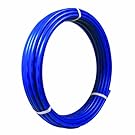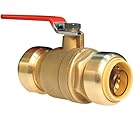 |
| Ball Valve |
 I have begun the final leg of my plumbing planning which includes listing all the PEX parts I am going to need to complete the plumbing of the Tiny House. I like PEX. I think that Shark Bite PEX looks easy and amazingly convenient, more so than sweating out copper pipes and worrying about elbows and such. With all the research I have done I figure PEX is the best bet for easy modifications and repairs. If you have never completed a plumbing project or are looking to modify or update plumbing, PEX is rapidly becoming the material of choice. Today I will explain the basics of PEX and why I am choosing it for my Tiny Home.
I have begun the final leg of my plumbing planning which includes listing all the PEX parts I am going to need to complete the plumbing of the Tiny House. I like PEX. I think that Shark Bite PEX looks easy and amazingly convenient, more so than sweating out copper pipes and worrying about elbows and such. With all the research I have done I figure PEX is the best bet for easy modifications and repairs. If you have never completed a plumbing project or are looking to modify or update plumbing, PEX is rapidly becoming the material of choice. Today I will explain the basics of PEX and why I am choosing it for my Tiny Home.If you are not familiar with PEX, it is flexible (somewhat flexible) tubing used to replace copper and PVC pipes. Cross-linked Polythylene, What makes PEX unique as opposed to PVC is the cross-linked bonds that form in the polymer structure when it is extruded into tubing. This causes thermoplastic to become thermoset and makes the tubing strong and durable. In lab tests PEX will take longer to burst vs Copper. Having had my home copper pipes freeze and burst in the past, this is an appealing aspect for me.
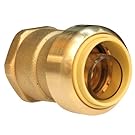 |
| Female Straight Coupling |
There are some advantages to using PEX over PVC or Copper:
- Flexible: Other than a short 90 degree turn, PEX is flexible and can curve instead of needing elbow joints
- Longer Lengths: Can be used due to less of a need for elbow joints. This potentially can reduce the risk of leaks because one continuous length of hose is used.
- Greater Water Pressure: See longer lengths. Better pressure is a result as well.
- Cost Effective: Less materials are required helping to reduce costs
- Reliable: PEX has a 25 year warranty, but most plumbers say it will last much longer.
- No Corrosion: Unlike Copper or Iron, PEX does not corrode
- Shark Bite Fittings: Super easy installation of connections (theoretically)
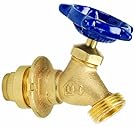 |
| Sillcock |
It is a daunting task trying to decide what runs where and what connections will be needed when you first sit down to plan your plumbing system. I already drew a diagram of the system as I imagine it, so I had good idea of what I would need. Based on the connection to my on-demand, tankless water heater, potable water tank, water pump, accumulator, etc., I decided to go with 1/2-inch PEX. PEX comes in 1/4-inch, 1/2-inch 3/4-inch, and 1-inch all the way up to 4-inches, but 1/2-inch is the most common for a household or tiny house application. I made a list of all the connections I would need (male vs female, straight, elbow, etc.) and then I went hunting online to see what connections/fittings are available. I found a ton of them on Ebay and Amazon, and ultimately chose Amazon because a good portion can be shipped free because I have Amazon Prime.
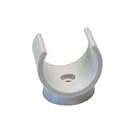 |
| PEX Clip |
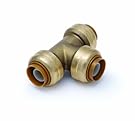 |
| 3 Way Tee Connection |
When planning the layout of the water system I was careful to take into consideration that the finished Tiny House will result in tight spaces that could make repairs later somewhat problematic. I plan to have ball valves in four spots along the system so that I can shut the water off where a leak or problem may be without compromising the rest of the system. In other words, if I need to repair the kitchen water line I don't want the shower to be cut off so I can still get water. Also, because space is tight, I want to make sure that I use sections of line that I can easily access and repair. For that reason I included some straight connector fittings just to allow for a break-off point to replace short sections. Clips will hold the pipes in place.
The cost to run the pipe for my tiny dwelling will be about $400, including an outside spigot. I do not feel this is a high cost based on the quality of the product and how long it should all last. Because the majority of the PEX tubing and plumbing will be inside the house, the risk of freezing pipes in winter is reduced, but the damage from leaks could be more costly.
Freezing pipes in winter can be problematic. I am aware that there are heaters that can be used in super cold climates to keep pipes from freezing. These heaters look like a long extension cord, plug into an outlet, and wrap around pipes, gently heating them to keep the fluid inside from forming ice crystals and becoming solid. The longer they are (the more pipe they wrap around) the more energy they draw. This is not an option for me because I am using an off the grid system and the amount of energy they draw would potentially drain my batteries in poor weather. However, if you are connected to the grid you may wish to consider using a pipe heater if the risk of your pipes freezing is significant enough. Otherwise you can do like I have and make sure there is air circulation where your pipes are so the heat of your home keeps the pipes nice and warm.
Freezing pipes in winter can be problematic. I am aware that there are heaters that can be used in super cold climates to keep pipes from freezing. These heaters look like a long extension cord, plug into an outlet, and wrap around pipes, gently heating them to keep the fluid inside from forming ice crystals and becoming solid. The longer they are (the more pipe they wrap around) the more energy they draw. This is not an option for me because I am using an off the grid system and the amount of energy they draw would potentially drain my batteries in poor weather. However, if you are connected to the grid you may wish to consider using a pipe heater if the risk of your pipes freezing is significant enough. Otherwise you can do like I have and make sure there is air circulation where your pipes are so the heat of your home keeps the pipes nice and warm.
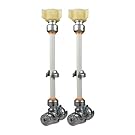 |
| Faucet/Toilet Connectors |
Here is a list of the parts I am using to complete my system:
- (1) Sillcock: Allows me to drain the system completely or to fill a bucket from the water tank (this will be outside the house, on the tongue side, under the trailer)
- (100) Clips: To secure the pipe down (sold in bags of 100)
- (1) Water Heater Installation Kit (fittings for the on-demand, tankless water heater)
- (4) Ball Joint Valve: Allows for shutting off the water along the system
- (10) Female Straight Coupling: Connects PEX to pumps and tanks
- (2) Toilet/Faucet Kit: Connect to faucets
- (1) Red PEX Pipe 100': Red for the hot water
- (2) Blue PEX Pipe 100': Blue for cold water
PEX requires a certain type of proprietary tool to install and it is generally close to, but under $100. My bf picked up a tool at a yard sale for $40, so you can find them cheaper than retail. You can also rent the tool, but I prefer to have one so that I can make emergency repairs or expand my system should I desire. Interested in how it is installed? Here is a short video explaining the process:
There are other options to choose from for plumbing, as I mentioned already, but the idea of sweating Copper or gluing PVC just does not really make me excited. I think that for a tiny house application PEX offers more pros than cons. Cost effective and easy installation are the factors that most impressed me. The fear of a leak and the damage it can do makes this gal want to install only the best.
